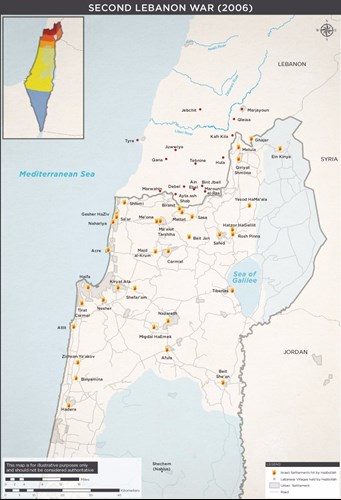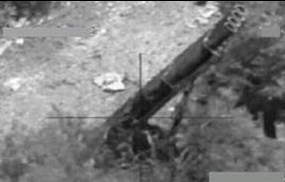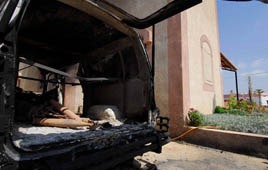The Second Lebanon War: A Timeline
Hezbollah, the Shiite Lebanese terror organization, has once again been making headlines. To this generation, they are mainly known for their intervention in the Syrian Civil War. Their fighting to prop up the regime of Bashar al-Assad alongside their patron, Iran, has played a role in further destabilizing an already volatile state. Long before Hezbollah was besieging Syrian cities, they were staging sophisticated attacks on Israel. In the summer of 2006, the attacks came to a head. Hezbollah kidnapped two IDF reservists, and Israel engaged with this threat on its northern border.
Throughout the war, the IDF used aerial and ground strikes to target Hezbollah positions, weapons caches, weapons transports, communications posts, bases, launch sites, and other targets. Hezbollah sheltered their fighters, weapons, and rocket launchers in civilian cities and towns throughout Southern Lebanon. The IDF continuously dropped leaflets in advance of operations urging civilians to leave these areas, and Hezbollah barred many from fleeing. Weapons were smuggled through humanitarian transport. Plainclothes Hezbollah militants were counted among the Lebanese civilian casualties. These tactics could also be seen during Operation Protective Edge, in which Hamas maximized civilian casualties in Gaza to prompt international condemnation against Israel.
Background:
On October 7, 2000, Hezbollah attacked and abducted IDF Staff Sergeants Adi Avitan, Omer Soued and Binyamin Avraham. Their bodies were held by Hezbollah until a 2004 prisoner exchange. Over the next six years, Hezbollah continuously attempted and carried out cross-border attacks against Israeli forces and civilians alike. They kidnapped Israeli civilians held them captive, and interrogated them. Additionally, Hezbollah used IEDs, rockets, and gunfire to kill and injure dozens of Israelis.

![]()
The War Begins
July 12, 2006
At 9 AM, Hezbollah launches Katyusha rockets and mortars at IDF positions and civilian border towns from Lebanon. Although five civilians are wounded, this attack was only a diversion. At the same time, a group of Hezbollah militants infiltrate Israeli territory and hide in a valley. The militants then ambush two IDF humvees that responded at the scene. Three soldiers are killed in the incident. Two reservists, 1st Sergeant Eldad Regev and Sergeant 1st Class Ehud Goldwasser, are kidnapped and taken into Lebanese territory.
When the two soldiers are found to be missing, the IDF sends a tank to pursue the kidnappers into Southern Lebanon. It hits an IED while crossing the border, killing the four soldiers in the tank. Another soldier comes under Hezbollah fire while attempting to remove the bodies from the tank, killing him as well. Two additional soldiers are wounded.
The IDF launches ground, air, and sea attacks aimed at Hezbollah positions in Southern Lebanon, and begins preparing reserve units.
July 13
Hezbollah begins bombarding Israeli civilians with rockets acquired from its main patron, Iran. Israelis living in the north are warned by the Home Front Command that they have about one minute to reach shelter once warning alarms sound. About 125 rockets, including 90 9K51 Grad rockets, hit Nahariya, Safed, and surrounding communities. These rockets killed two Israeli civilians and wounded 67. The IDF drops leaflets in Southern Lebanon urging civilians to flee to safety. The IDF strikes multiple Hezbollah positions, warehouses, and strongholds, including Hezbollah headquarters and Hezbollah’s Al-Manar TV station broadcast tower.
July 14
Hezbollah fires over 100 Katyusha rockets into Israel, killing two Israeli civilians and wounding 19 more. Two surface-to-sea C-701 Cruise Missiles are fired from Hezbollah territory. One hits an Egyptian civilian vessel, damaging it, and another hits Israeli Navy Ship Hanit. Four crew members are killed in the attack.

Katyusha rocket launchers in southern Lebanon
The IDF hits hundreds of Hezbollah targets with aerial attacks and artillery shelling, including Hezbollah offices, and the road linking Southern Lebanon to Damascus. This road was a primary means for weapons to be trafficked.
Prime Minister Ehud Olmert lays out the conditions for a ceasefire, calling for the implementation of United Nations Security Council Resolution 1559. The resolution would disarm Hezbollah, demand the return of the two abducted soldiers, and put an end to the rocket attacks on Israeli towns.
July 15
Hezbollah fires 100 rockets into Israel, reaching the city of Tiberias for the first time and leaving 16 civilians wounded. The Minister of Defense calls for a state of emergency on the home front. The IDF continues to target Hezbollah positions in Southern Lebanon.
July 16
Hezbollah fires 47 rockets into Israel, killing 8 civilians and wounding 77 more in the northern port city of Haifa. Rockets also hit Nazareth and Afula, extending the reach of Hezbollah’s attacks. The IDF continues striking Hezbollah positions and drops leaflets over Nabatiyeh and seven other villages, urging civilians to leave Hezbollah-controlled areas.
July 19
Hezbollah fires 116 rockets into Israel, killing Israeli-Arab children from the city of Nazareth and wounding 18 more. The IDF strikes Hezbollah weapons caches, launch sites, command posts, and communications infrastructure. Two Israeli soldiers are killed and seven more injured in a firefight with Hezbollah militants in Southern Lebanon.
Ground Operation
July 22
Hezbollah fires 129 rockets into Israel, wounding 35 civilians. The IDF begins a limited ground mobilization, sending 2,000 troops into Southern Lebanon. The IDF begins Operation Webs of Steel, and takes over the Hezbollah-held town of Maroun al-Ras.


The IDF destroyed a vehicle in Southern Lebanon carrying missiles for Hezbollah. A missile stockpile was also found in the basement of the village mosque (pictured in the background)
July 24
Hezbollah fires 111 rockets into Israel, wounding 17 civilians. The day before, the IDF dropped leaflets urging Lebanese civilians to move northwards. The IDF launches Operation Webs of Steel 2 to take the Hezbollah-held town of Bint Jbeil. Lasting into mid-August, this would become one of the war’s bloodiest battles. Multiple IDF soldiers and dozens of Hezbollah fighters, including several commanders, were killed in the battle.
July 26
Hezbollah fires 169 rockets into Israel, wounding 32 civilians. As Operation Webs of Steel 2 continues, Major Roi Klein of the Golani Brigade jumps on a grenade, saving the lives of his fellow soldiers. He is posthumously awarded the Medal of Courage and the Head of Regional Command citation.
July 29
Hezbollah fires 86 rockets into Israel, wounding 10 civilians. The IDF withdraws from Bint Jbeil. Over the course of the five-day battle, eight IDF soldiers and 50-70 Hezbollah militants were killed. Patriot missiles are deployed north of Tel Aviv in response to Hezbollah’s firing of a long-range Khaibar-1 rocket at the town of Afula.
July 31
Hezbollah fires six rockets into Israel, wounding 25 civilians. A period of restraint begins at 2 AM, marking a drawback in IDF strikes outside of Hezbollah’s main holdings. Operation Webs of Steel 4 begins in the town of Ayta ash-Shab, a bloody battle with dozens of IDF casualties.
August 1
Hezbollah fires four rockets into Israel with no civilian casualties. The IDF launches Operation Sharp and Smooth in Baalbek. IDF soldiers from the Shaldag and Sayeret Matkal special forces units, raid a hospital that Hezbollah has been using as its headquarters. All of the patients had been evacuated a few days earlier. Combatants mixed with civilians taking shelter, putting them in the line of fire.
August 2
After two days of relative quiet, Hezbollah fires 230 rockets into Israel, killing one civilian and wounding 88 more. The IDF expands its operations in Southern Lebanon.
August 3
Hezbollah fires 213 rockets into Israel, killing eight civilians and wounding 76 more. The IDF captures the western part of Bint Jbeil, where clashes continue. Hezbollah leader Hassan Nasrallah declares that if the IDF attacks their positions in Beirut, Hezbollah will carry out terror attacks in Tel Aviv.
August 5
Hezbollah fires 170 rockets into Israel, killing four civilians and wounding 50 more. IDF commandos raid the apartment of a Hezbollah terrorist responsible for launching rockets into Israel, including the long-range rocket that struck the town of Hadera the day before. The IDF and Hezbollah exchange fire.
August 7
Hezbollah fires 185 rockets into Israel, wounding 12 civilians. The IDF drops fliers in Lebanon urging civilians not to travel south of the Litani River, the area from which Hezbollah fires the majority of its rockets into Israel.
August 10
Hezbollah fires 155 rockets into Israel, killing two civilians (including one child) from the town of Deir al-Assad, and wounding 21 more. Hassan Nasrallah calls on Israeli Muslims to evacuate the city of Haifa, where Jews and Arabs have long coexisted in peace. Nasrallah did not wish to spill Muslim blood in the continued Hezbollah strikes on Israel’s third-largest city. The IDF captures the town of Marjayoun, and heavy clashes continue.
August 11
Hezbollah fires 123 rockets into Israel, wounding 26 civilians. The IDF expands its ground incursion up to the Litani River.
At 9:00 PM, the United Nations Security Council drafts Resolution 1701, which calls for a permanent ceasefire, the Israeli withdrawal from Lebanon, the permanent disarmament of all militias operating in Lebanon (including Hezbollah and the PLO), and no armed forces with the exception of UNIFIL and the Lebanese Army south of the Litani. It additionally called for Lebanese sovereignty over the whole of the country and the unconditional return of the abducted Israeli soldiers, among other demands.
August 13
Hezbollah fires 217 rockets into Israel, killing one civilian and wounding 105 more. The IDF continues to strike Hezbollah positions and command posts, uncovering and destroying a ready-to-launch Fagot missile and rocket launch sites. 40 Hezbollah terrorists are killed in 24 hours, and the terror group’s infrastructure suffers major blows.
August 14
The last IAF airstrike is carried out. At 8 AM, the ceasefire goes into effect, and the IDF ceases all operations. The IDF calls to the citizens of northern Israel to remain in the shelters and await further instructions as 50 Katyusha rockets, 8 Kornet missiles, and other rockets continue to be found in Southern Lebanon. Civilians begin returning to Southern Lebanon. Despite the ceasefire, Hassan Nasrallah declares that the IDF troops in Southern Lebanon, waiting to be switched out by their UNIFIL and Lebanese Army counterparts, are still fair targets.
Post Ceasefire
August 15
Hezbollah violated the ceasefire by firing 10 Katyusha rockets at Israel from north of the Litani River. However, all of the rockets fell short of the Israeli border. Hezbollah militants who continue advancing on IDF soldiers are met with fire, killing 9 of them. Despite these small-scale clashes, the ceasefire holds, and the IDF does not respond to the rocket fire. UNIFIL begins replacing the IDF soldiers in Southern Lebanon over the course of 48 hours.
August 19
Syrian guerillas transferring an arms shipment from Iran to Hezbollah, in clear violation of Resolution 1701, are intercepted by the IDF.
Aftermath
49 Israeli civilians and 121 IDF soldiers were killed in the 2nd Lebanon War. 1,384 civilians and 1,244 IDF soldiers were wounded. Over the course of the month-long war, Hezbollah fired 3,990 rockets on Israeli population centers.
Hezbollah has since refused to abide by Resolution 1701. Though the resolution called for the unconditional release of the kidnapped soldiers, the bodies of 1st Sgt. Eldad Regev and Sergeant 1st Class Ehud Goldwasser were not returned until July 2008. The bodies were returned in a prisoner exchange for Samir Kuntar and other known terrorists. As Israel finally laid the two soldiers to rest, Lebanon cheered the return of the terrorist. Hezbollah has not disarmed and both Iran and Syria continue to openly supply the terror organization, also in direct violation of Resolution 1701. They have also continued to attempt and carry out multiple international terror attacks on Jewish and Israeli targets. Attacks have been carried out in Istanbul, Cyprus, and Bulgaria.
Since the war, Hezbollah has repeatedly disturbed the peace on the Israel-Lebanon border. They have planted landmines and IEDs on the border, killing a 14-year-old Israeli and wounding three civilians and 10 IDF soldiers. In a blatant attempt to renew the violence, Hezbollah continued to fire rockets and missiles into Israeli territory during Operation Protective Edge in the summer of 2014, injuring two Israeli children with the shrapnel. In January 2015, Hezbollah fired a missile at an IDF convoy on the Israeli side of the border, killing two soldiers. In January 2016, Hezbollah detonated an additional roadside bomb against Israeli soldiers.
Though they suffer heavy losses in Syria, Hezbollah is continuing to stockpile long-range missiles and threaten the safety of Israel. One just needs to hear the speeches of Hezbollah leader, Hassan Nasrallah, to understand the organization’s intentions – in a speech last February, Nasrallah claimed “Several missiles launched from here together with the ammonia containers in Haifa would lead to the same impact as a nuclear bomb.” Through the support of Iran and Syria and through the economic support they have gained through the South American drug trade, their capabilities to inflict real harm has only grown, despite Resolution 1701. In doing so, and in continuing to build their terror infrastructure throughout the civilian towns of Southern Lebanon, they continue to endanger the innocent people they claim to be protecting.

